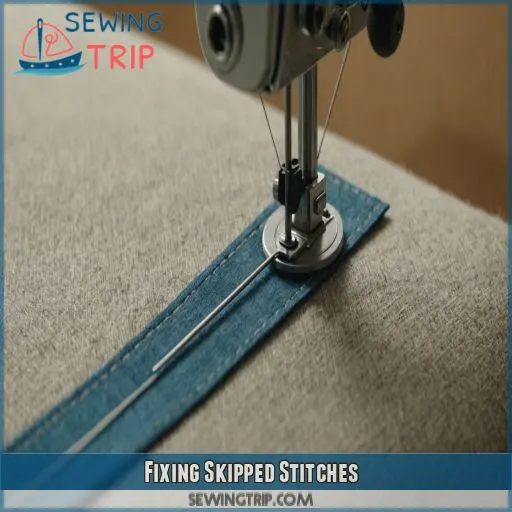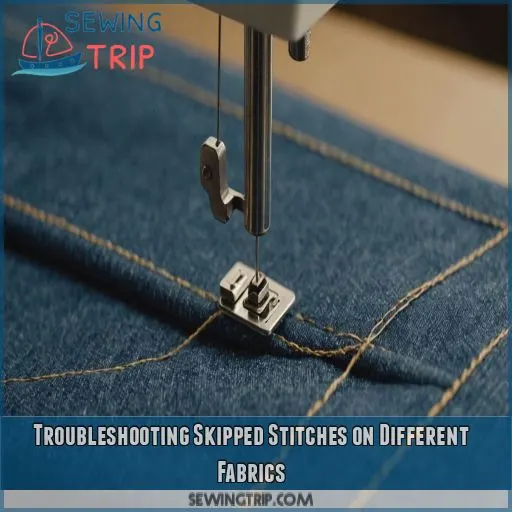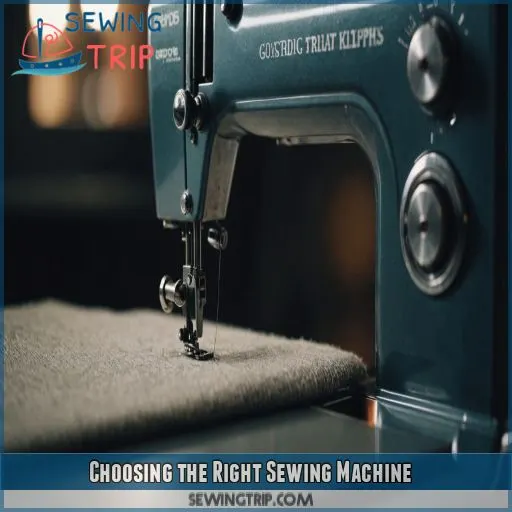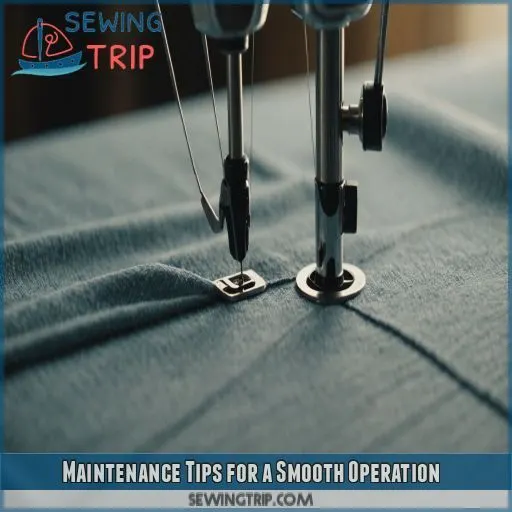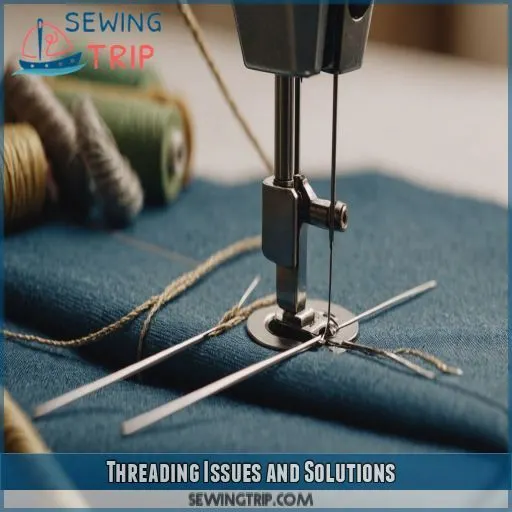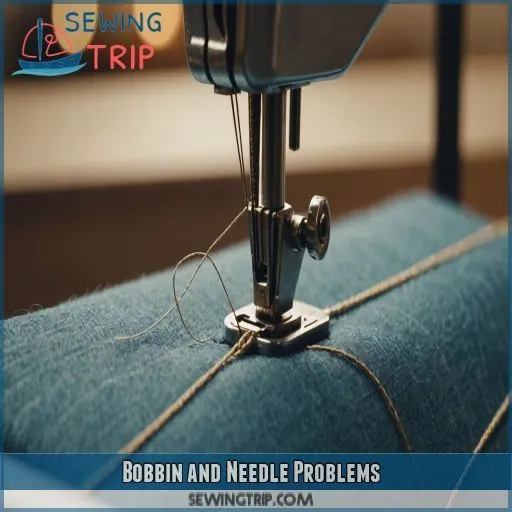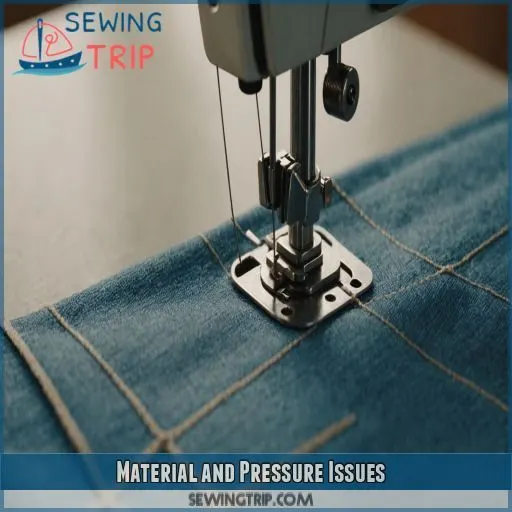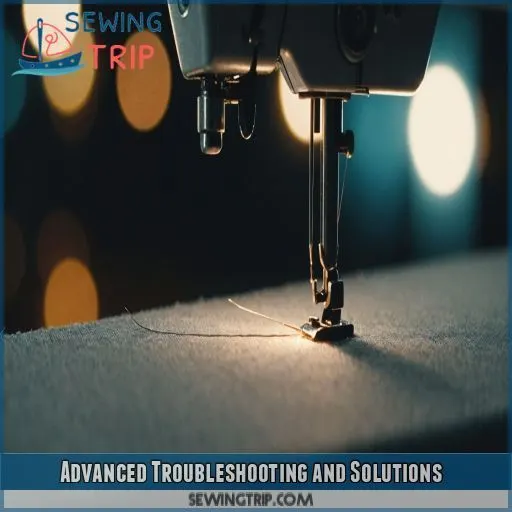This site is supported by our readers. We may earn a commission, at no cost to you, if you purchase through links.
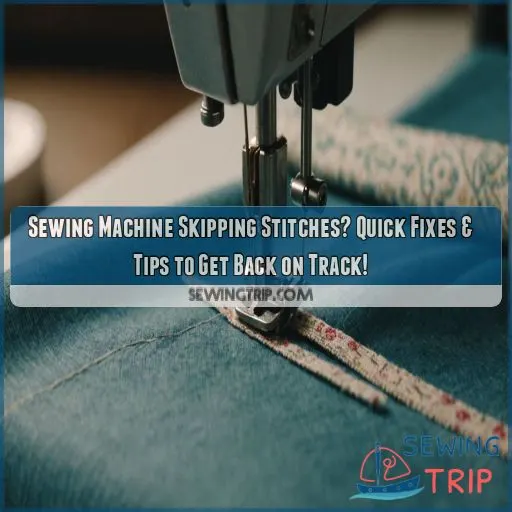 Skipped stitches are a common sewing frustration.
Skipped stitches are a common sewing frustration.
You’re not alone!
If your sewing machine is skipping stitches, it’s likely due to a simple issue like incorrect tension, a dull needle, or a clogged machine.
Try re-threading the upper thread to relieve tension and check the bobbin for looseness or damage.
If that doesn’t work, it’s time to change the needle – a new one can work wonders!
To get your stitches back on track, it’s important to find the right solution for your Sewing machine skipping stitches.
Let’s get to the bottom of this and get your stitches back on track!
Table Of Contents
- Key Takeaways
- Common Causes of Skipped Stitches
- Fixing Skipped Stitches
- Troubleshooting Skipped Stitches on Different Fabrics
- Choosing the Right Sewing Machine
- Maintenance Tips for a Smooth Operation
- Threading Issues and Solutions
- Bobbin and Needle Problems
- Material and Pressure Issues
- Advanced Troubleshooting and Solutions
- Frequently Asked Questions (FAQs)
- Conclusion
Key Takeaways
- You’re not alone in the skipped stitch struggle! It’s often a simple fix, like re-threading, adjusting tension, or changing your needle. Try these DIY fixes before calling in the experts.
- Don’t underestimate the power of a good needle! A dull or damaged needle is a common culprit behind Skipped stitches. Swap it out for a sharp new one, and make sure it’s the right type and size for your fabric.
- Your sewing machine is like a car – it needs regular maintenance to run smoothly. Clean it every 1-3 months, or after each big project, to prevent lint and dust buildup. This will reduce the risk of skipped stitches and other issues.
- It’s not just about the machine – your fabric handling techniques can also cause skipped stitches. Get a grip on the right techniques, like using the correct presser foot pressure and guiding the fabric smoothly, to tame that temperamental fabric and reduce Stitch skipping.
Common Causes of Skipped Stitches
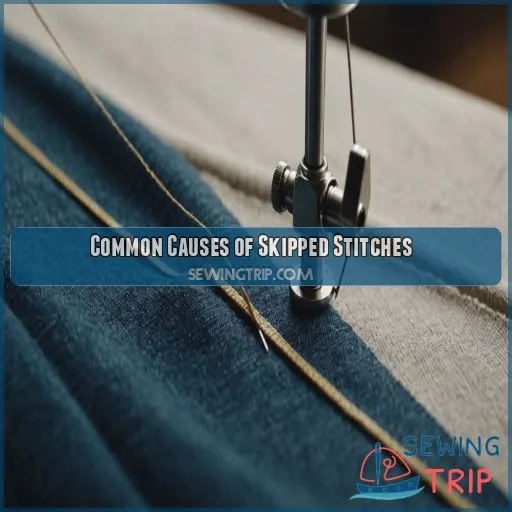
Skipped stitches can happen to anyone, and they’re usually due to a few common issues. We’ll show you the typical culprits and how to get your sewing groove back.
Incorrect Settings and Tension
Skipped stitches often stem from incorrect settings and tension issues. Here’s how to get your sewing groove back:
- Stitch length matters: Too long, and your machine may skip, especially on delicate fabrics.
- Tension adjustment: The wrong top or bottom thread tension can cause skipped stitches. Adjust it according to your fabric type.
- Fabric, needle size, and thread weight: Make sure they’re a match made in heaven. The wrong combo can lead to tension issues and skipped stitches.
Threading Issues and Thread Quality
Threading issues and poor thread quality are common causes of skipped stitches. Check your thread type, tension, and guides to make sure they’re suitable for your fabric and machine. Avoid over-tightening, which can lead to breakage. Here’s a quick reference guide to help you troubleshoot:
| Thread Issue | Cause | Solution |
|---|---|---|
| Thread breakage | Over-tightening | Adjust thread tension |
| Skipped stitches | Incorrect thread type | Choose suitable thread type |
| Uneven stitches | Misaligned thread guides | Realign thread guides |
Bobbin Problems and Needle Issues
Don’t let bobbin problems and needle issues ruin your sewing flow! Check your bobbin tension and needle size to make sure they’re compatible with your thread type. Here are three common causes of skipped stitches:
- Incorrect bobbin tension: Too loose or too tight can cause skipped stitches.
- Wrong needle size: Using a needle that’s too small or too large can lead to uneven stitches.
- Poor needle position: Make sure your needle is properly seated and aligned to avoid skipped stitches.
Dirt Accumulation and Machine Maintenance
Don’t let dirt and grime sabotage your sewing sessions! Regular cleaning and maintenance can prevent skipped stitches and prolong your machine’s lifespan. Remove lint and debris from the bobbin case, oil moving parts, and schedule periodic servicing. By taking preventative care, you’ll enjoy smooth, stress-free sewing and extend the life of your trusty machine.
Fixing Skipped Stitches
You’re staring at a row of uneven stitches, wondering what went wrong – don’t worry, it’s an easy fix! Let’s troubleshoot together to get your sewing machine humming along smoothly again, starting with the most common solutions to skipped stitches.
Changing the Needle for Smooth Stitches
A dull or damaged needle is a common reason for skipped stitches.
Check your needle size, type, and brand to make sure it’s compatible with your fabric and thread.
Replace it with a sharp new one.
Adjust your sewing machine settings accordingly.
This simple fix can get your stitches back on track in no time!
Re-threading the Upper Thread for Tension Relief
Now that you’ve changed your needle, let’s tackle re-threading the upper thread for tension relief. Make sure to follow the upper thread path and guide it through the tension guide. Remove any tangles from the thread spool and re-thread the machine according to the manual. Proper re-threading will help you achieve the perfect needle tension, eliminating those pesky skipped stitches.
Checking the Bobbin for Looseness and Damage
Now that you’ve re-threaded the upper thread, let’s tackle the bobbin. Check if it’s loose or damaged, as this can cause skipped stitches. Inspect the bobbin case for any blockages or tangles. If you find any issues, try re-winding the bobbin or replacing it if necessary. Proper bobbin tension is key to smooth stitching.
Cleaning the Machine for Optimal Performance
Now that you’ve checked the bobbin, it’s time to give your machine a good cleaning.
Use a soft brush to remove lint and debris from the bobbin area and presser foot.
Apply a few drops of oil to moving parts, and wipe down the machine with a damp cloth.
Regular cleaning will keep your machine running smoothly and prevent skipped stitches.
Troubleshooting Skipped Stitches on Different Fabrics
You’ve mastered the basics of fixing skipped stitches, but now you’re facing a new challenge: troubleshooting skipped stitches on different fabrics. Whether you’re working with thick fabrics, stretchy materials, or delicate knits, you’ll need to adjust your approach to get the smooth, even stitches you want.
Thick Fabrics and Adjusting Presser Foot Pressure
Thick fabrics can be a challenge! To avoid skipped stitches, try these tweaks:
- Heavier needle: Switch to a larger needle size to handle thicker threads and fabrics.
- Bulky seam aid: Use a bulky seam aid tool to help guide the fabric and prevent bunching.
- Increased presser foot pressure: Adjust the presser foot pressure to make sure the fabric is held firmly in place.
Stretch Fabrics and Using Stretch Needles
When sewing stretch fabrics, skipped stitches can be a real pain. To avoid this, use a stretch needle, which is designed to flex with the fabric. Also, switch to a walking foot or a presser foot with a small round hole to help guide the fabric smoothly. This combo will help you conquer stretchy fabrics with ease!
Knit Fabrics and Using Fusible Interfacing
When sewing knit fabrics, skipped stitches can be a real pain. To minimize this issue, try using fusible interfacing to stabilize the fabric. Here are some tips to keep in mind:
- Choose a lightweight fusible interfacing suitable for knit fabrics.
- Apply the interfacing to the wrong side of the fabric, following the manufacturer’s instructions.
- Use a stretch needle and a walking foot or roller foot to help guide the fabric.
- Keep your seam allowance consistent to prevent distortion.
- Refer to your sewing machine manual for specific guidance on sewing knit fabrics with fusible interfacing.
Zigzag Stitches and Checking for Common Causes
Now that you’ve mastered knit fabrics, let’s tackle zigzag stitches! To troubleshoot skipped stitches, check your zigzag stitch tension, needle selection, and bobbin winding. Make sure your stitch width is suitable for the fabric type. Don’t forget to adjust your needle position and thread tension. With these expert tips, you’ll be sewing like a pro in no time!
Choosing the Right Sewing Machine
When your sewing machine starts skipping stitches, it’s often a sign that you’re using the wrong machine for the job—or that your trusty sidekick is due for an upgrade.
You might be wondering, "What kind of sewing machine is right for me?"
This section will help you explore the different types of sewing machines and find the perfect match for your sewing style, whether you’re a beginner, intermediate sewer, or seasoned pro.
Simplicity and Ease of Use for Beginners
As a beginner, you want a sewing machine that’s easy to use and won’t intimidate you. Look for machines with basic features like straight stitch, zig-zag stitch, and buttonhole. Consider automatic needle threading and adjustable stitch length for a hassle-free experience. Beginner-friendly machines are out there – find one that fits your needs and budget!
Advanced Features and Versatility for Intermediate Sewers
As an intermediate sewer, you’re ready for a machine that can keep up with your creativity.
Look for advanced features like embroidery, decorative stitches, and quilting functions.
A free arm is a must for sewing sleeves and cuffs.
Consider a machine with adjustable foot pressure and thread tension for fine-tuning your stitches.
Buttonholes and automatic needle threading are also a plus.
High-End Features and Customization for Professionals
You’re a pro, and you need a sewing machine that can keep up! Look for high-end features like programmable stitches, advanced needle systems, and custom foot options. These machines are built for speed and precision, with industrial-grade parts that can withstand heavy use. Here are some key aspects to think about:
- Programmable stitches for customized sewing
- Advanced needle systems for precision and speed
- Custom foot options for specialized sewing tasks
- High-speed sewing capabilities for maximum efficiency
Sewing Machines for Specific Needs and Tasks
You’re ready to take your sewing to the next level, but which machine is right for you? Check out this handy guide to find your perfect match.
| Machine Type | Best For | Key Features |
|---|---|---|
| Embroidery Machines | Intricate designs | Large embroidery area, built-in designs |
| Quilting Machines | Quilting projects | Larger throat space, walking foot |
| Serger Machines | Finishing seams | 2-4 threads, differential feed |
| Combination Machines | Versatility | Multiple functions, adjustable stitch options |
Choose the right machine and boost your sewing skills!
Maintenance Tips for a Smooth Operation
You’ve fixed those pesky skipped stitches, but to keep your sewing machine running smoothly, you need to show it some TLC. Regular maintenance is key to preventing problems and ensuring your machine stays in top shape, so let’s get started with some simple tips to keep it purring along.
Regular Cleaning and Lubrication
Now that you’ve chosen the right sewing machine, it’s time to keep it running smoothly! Regular cleaning and lubrication are key. Use a soft brush and compressed air to remove dust and debris, and follow the manufacturer’s lubrication schedule. Choose the right lubricant type for your machine, and apply it sparingly to avoid attracting dust.
Needle Replacement and Proper Storage
Time to swap out that old needle! Regular replacement prevents skipped stitches and fabric damage. Store your needles in a dry, organized case to keep them sharp and prevent rust. Check your sewing machine’s manual for the recommended needle type and lifespan. Don’t sharpen needles, it’s not worth the risk – just replace them!
Professional Service and Technical Support
Don’t neglect your sewing machine’s maintenance! Regular professional service can prevent skipped stitches and costly repairs. Check your warranty and service intervals to avoid surprise repair costs. Look for authorized dealers and sewing machine experts with great customer reviews. Consider taking a sewing machine expert workshop or class to learn more about maintenance and troubleshooting.
Threading Issues and Solutions
You’re in the middle of a sewing project, and your machine starts skipping stitches – it’s frustrating, but don’t worry, it’s often an easy fix. In this section, we’ll walk you through common threading issues and solutions to get your machine humming along smoothly again.
Correct Threading and Needle Insertion
To avoid skipped stitches, make sure you’re threading your machine right and inserting the needle correctly.
Check your sewing machine’s manual or a threading diagram for help.
Use the right needle type and gauge for your fabric and thread.
Top-loading bobbins can be a bit tricky, so double-check the thread tension.
If you’re still unsure, refer to a sewing machine expert article or video for personalized advice.
Threading Issues and Needle Size
Picking the right needle size for your thread is key. If your needle is too small for the thread, you’ll get skipped stitches. On the other hand, a needle that’s too big will lead to loose stitches. To avoid this, check your sewing machine’s manual for the recommended needle size and thread compatibility.
- Use a needle size chart to figure out the right match
- Check the thread’s weight and type to pick the right needle
- Avoid using a needle that’s too small for thick threads
- Consult a sewing machine expert or take a course for personalized guidance
Threading Issues and Needle Type
Now that you’ve checked your needle size, let’s talk about needle type. Using the wrong needle type can cause skipped stitches, so make sure you’re using a needle designed for your fabric. Consult your sewing machine expert or manual to determine the correct needle system and type for your machine and project. Adjust your thread tension accordingly.
Bobbin and Needle Problems
You’re probably no stranger to the frustration of skipped stitches, and it’s often your bobbin and needle that are the culprits behind this sewing snag. Let’s get to the bottom of the common bobbin and needle problems that can cause your sewing machine to skip stitches, and explore some practical solutions to get your sewing back on track.
Empty Bobbin and Needle Replacement
You’re in the middle of a sewing project and your machine starts skipping stitches. Don’t panic! Check your bobbin – is it empty? Replace it with a filled one. Also, consider changing your needle, especially if you’re sewing thick or abrasive fabrics. A sharp needle can make all the difference in stitch quality.
- Always wind your bobbin correctly to avoid tangles and knots.
- Use the right needle type for your fabric and thread.
- Check your sewing tension to make sure it’s not too tight or too loose.
- Regular machine maintenance can prevent skipped stitches and other issues.
- Follow sewing machine expert tips on Twitter, Pinterest, and TikTok for more troubleshooting advice.
Bent Needle and Incorrect Needle Size
You’ve checked the bobbin, now it’s time to inspect the needle. A bent needle can cause skipped stitches, so replace it with a new one. Make sure you’re using the correct needle size and type for your fabric. Refer to the needle size chart below:
| Fabric Type | Needle Type | Needle Size |
|---|---|---|
| Cotton | Sharp | 8-10 |
| Knit | Ballpoint | 6-8 |
| Denim | Heavy Duty | 10-12 |
| Silk | Sharp | 6-8 |
Replace the needle and try sewing again. If issues persist, consult a sewing machine expert or manufacturer’s guide.
Needle Position and Feed Dog Adjustment
Let’s get your sewing machine humming again! If you’re experiencing skipped stitches, check the needle position and feed dog adjustment. Here are some quick fixes:
- Adjust the feed dog height to make sure the fabric feeds smoothly.
- Check the needle depth and needle alignment to make sure it’s in the right spot.
- Verify the feed dog timing and needle plate gap to get the best results.
Material and Pressure Issues
You’re halfway through your sewing project, and your machine starts skipping stitches. It’s frustrating, but don’t worry, it’s often an easy fix related to the material or pressure settings.
This section will walk you through the common material and pressure issues that can cause skipped stitches.
We’ll also provide you with practical solutions to get your sewing machine back on track.
Insufficient Presser Foot Pressure
When your presser foot pressure is off, your stitches can be too. Don’t worry, it’s an easy fix! Check your machine’s manual for foot pressure adjustment instructions. The right pressure depends on fabric thickness and type. Here’s a quick guide:
| Fabric Type | Presser Foot Pressure |
|---|---|
| Thin fabrics | Light pressure |
| Medium fabrics | Medium pressure |
| Thick fabrics | Heavy pressure |
| Stretch fabrics | Light to medium pressure |
Lower Thread Length and Upper Thread Size
When your sewing machine skips stitches, check the lower thread length and upper thread size. If the lower thread is too short, it can cause tension issues. Try these fixes:
- Pull more thread: Give the lower thread some extra slack (about 4-5 inches) to reduce tension.
- Check the bobbin: Make sure it’s not too tightly wound, which can also cause tension problems.
- Adjust the upper thread size: If it’s too large for the needle, swap it for a smaller one to achieve a smooth stitch.
Material Compatibility and Pressure Adjustment
When working with different materials, you’ll want to adjust your sewing machine’s pressure and choose the right fabric-needle pairing. Here’s a quick guide to get you started:
| Material | Pressure Foot Type |
|---|---|
| Thin fabrics (cotton, silk) | Standard presser foot |
| Thick fabrics (denim, canvas) | Walking foot or Teflon foot |
| Stretch fabrics (knit, spandex) | Walking foot or stretch foot |
| Delicate fabrics (lace, chiffon) | Delicate presser foot or Teflon foot |
Adjust your machine’s tension and stitch selection accordingly for a smooth sewing experience.
Advanced Troubleshooting and Solutions
You’ve tried the basics, but your sewing machine is still skipping stitches – now it’s time to get a little more serious about troubleshooting. In this section, we’ll walk you through some advanced solutions to help you identify and fix the problem, from thread and needle compatibility to hook timing and technical support.
Thread and Needle Compatibility
Now that we’ve tackled material and pressure issues, let’s get to the nitty-gritty of thread and needle compatibility. If your needle is too large for your thread, you’ll get skipped stitches. Check your needle size and thread weight to make sure they’re compatible. A simple switch to a smaller needle or lighter thread can get your stitches back on track.
Hook Timing and Hook Point Damage
If your sewing machine is skipping stitches, hook timing might be the culprit.
Double check your manual to make sure the hook and needle are in sync.
A damaged hook can also cause issues.
Inspect the hook point for signs of wear or damage.
If it’s damaged, consider replacing it.
Proper hook timing and a healthy hook point can get your stitches back on track.
Machine Malfunction and Technical Support
Your sewing machine’s skipped stitches got you stumped? Don’t worry, it’s not you, it’s the machine! If you’ve tried all the troubleshooting steps and still can’t resolve the issue, it’s time to call in the experts. Check your warranty, estimate repair costs, and reach out to customer service for guidance.
- Check your machine manual for troubleshooting guides specific to your model.
- Contact the manufacturer’s customer service for personalized support.
- Look for online resources, such as YouTube tutorials or sewing forums, for help from experienced sewers.
- Consider consulting a professional sewing machine technician for a thorough diagnosis and repair.
Frequently Asked Questions (FAQs)
How to fix a sewing machine that skips stitches?
Did you know 75% of sewing machine issues are caused by improper threading or tension? To fix skipped stitches, try re-threading, adjusting tension, and changing your needle – it’s an easy DIY fix that’ll get you sewing smoothly!
What remedy should be done for skipped stitches?
To fix skipped stitches, try changing the needle, re-threading the upper thread, and checking the bobbin for loose thread or knots. Regularly clean the machine and make sure the thread is the correct type and quality for the fabric.
Why do I get the occasional skipped stitches?
You’re getting skipped stitches because your machine’s settings, threading, or needle might be off. Check your stitch length, tension, and thread quality. A dull or damaged needle can also cause uneven stitches, so try swapping it out.
Why does my top thread keep breaking and skipping stitches?
80% of sewing machine issues stem from improper threading! If your top thread keeps breaking and skipping stitches, re-thread the machine, ensuring the thread passes through all guides, and adjust the tension for a smooth stitch flow.
What is the best way to prevent skipped stitches altogether?
To prevent skipped stitches, check your needle regularly and replace it when necessary. Also, make sure you’re using the right thread and tension for your fabric, and don’t forget to clean your machine often to avoid dust buildup.
Can using old or low-quality threads cause skipped stitches?
Yep, old or low-quality threads can definitely cause skipped stitches! If you’re using threads that are past their prime or aren’t designed for your fabric, it’s time to switch to a fresh, high-quality thread that’s up to the task.
How often should I clean my sewing machine to prevent issues?
You should clean your sewing machine every 1-3 months, or after each big project, to prevent lint and dust buildup. Regular cleaning keeps your machine running smoothly, reducing the risk of skipped stitches and other issues.
Can skipped stitches be caused by incorrect fabric handling techniques?
You’re wrestling with skipped stitches, and you’re wondering if it’s your fabric handling techniques that are to blame. Yes, incorrect fabric handling can cause skipped stitches, so let’s get a grip on the right techniques to tame that temperamental fabric.
Are there any specific sewing machine features that reduce skipped stitches?
You’re in luck! Some sewing machines come with features that help reduce skipped stitches, like automatic tension, adjustable stitch length, and specialized needles. Look for these features when shopping for a new machine to minimize stitch skipping.
Conclusion
You’ve finally tamed the beast – your sewing machine is purring along, stitches flowing smoothly.
But remember, skipped stitches can creep back in if you don’t stay vigilant.
Keep your machine well-maintained, and don’t hesitate to troubleshoot when issues arise.
With these quick fixes and tips, you’ll be back on track in no time.
Your sewing machine skipping stitches solution is just a thread away – stay calm, stay patient, and keep on sewing!

